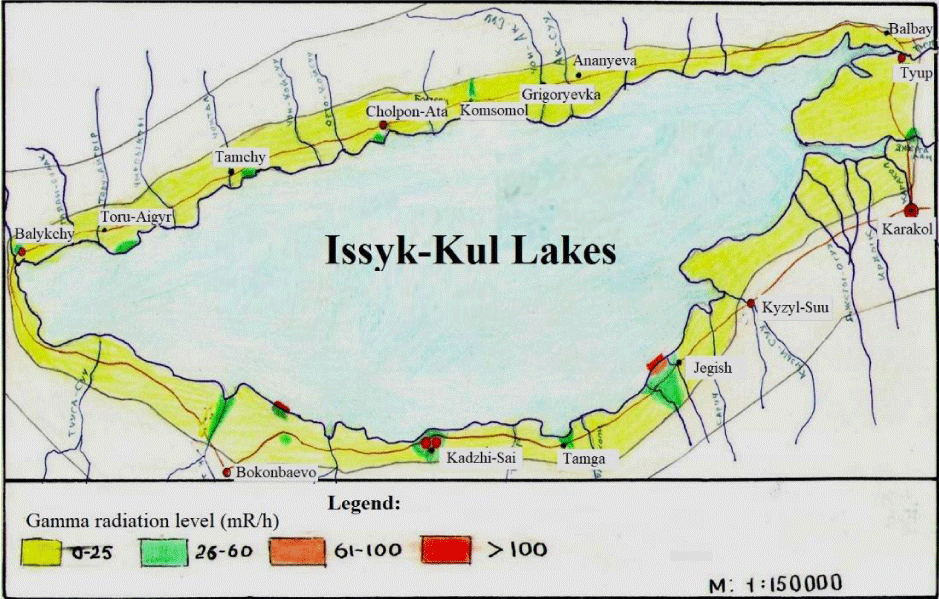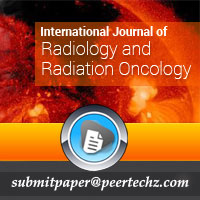International Journal of Radiology and Radiation Oncology
Radon in water and soil cover in the coastal zone of Issyk-Kul
Djenbaev BМ*, Dzhamanbaeva ZA, Zholboldiev BT, Zhalilova AA, Karmisheva UZh, Zhumaliev TN and Mamatibraimob S
Cite this as
Djenbaev BМ, Dzhamanbaeva ZA, Zholboldiev BT, Zhalilova AA, Karmisheva UZh, et al. (2024) Radon in water and soil cover in the coastal zone of Issyk-Kul. Int J Radiol Radiat Oncol 10(1): 001-003. DOI: 10.17352/ijrro.000053Copyright License
© 2024 Djenbaev BМ, et al. This is an open-access article distributed under the terms of the Creative Commons Attribution License, which permits unrestricted use, distribution, and reproduction in any medium, provided the original author and source are credited.The article summarizes the results of the study of the Issyk-Kul coastal zone - exposure dose, total alpha- and beta-activity, radon in the lake water, and soil cover. Our studies have established that radionuclide contamination is mainly natural in some coastal areas (thorium sands of Zhenish and Ak-Terek) and of natural-technogenic nature in the area of Kadzhi-Sai tailing dump. The nature of contamination is spotty, where rocks are enriched and located closer to the soil cover. Gamma-radiation exposure dose rates of the coastal zone of Lake Issyk-Kul by soil types showed that in general at the background level (from 19 ± 3 to 34 ± 6 µR/h) and below the accepted norm. On separate natural-technogenic sites (Kadzhi-Sai tailing dump, thorium sands Zhenish and Ak-Terek) gamma radiation exposure dose rate, total alpha-activity, and isotopic composition are increased from 2 to 8 times compared to background sites.
Relevance
It is known that the Issyk-Kul basin on the territory of Kyrgyzstan is a natural uranium province (Kovalsky, Vorotnitskaya, 1968). The study of natural radioactivity is not only of scientific interest but also of great practical importance. The importance of this problem was repeatedly emphasized by famous scientists and Academicians V.I. Vernadsky (1927), A.P. Vinogradov (1957), Professors V.V. Kovalsky (1964), and other researchers. The scientific importance of this problem increased after the discovery of artificial radioactivity. It was established that a certain “radiation”, called radioactivity, penetrates the living body. This radiation turned out to be strongly affecting the living body as a whole and human beings [1-3].
Of great theoretical and practical interest is the non-uniformity of radioactive background in natural conditions, which depends on latitude and altitude above sea level. The lake is located at an altitude of 1600 m above sea level and is the second largest mountain lake after Titicaca in South America It is a brackish water lake surrounded by forests and mountain ranges. To preserve the unique ecosystems of Issyk-Kul as an object of world historical and cultural heritage allowed the creation of the biosphere territory “Issyk-Kul” on September 25, 1998 year, and included in the UNESCO World Network of Biosphere Reserves (2001 year). Also, in the Tien Shan mountains, there is another wealth - hydrothermal radioactive springs with hot water, which are located mainly in the northern part of the country in the Issyk-Kul Basin (radon springs Kadzhi-Say, Bar-Bulak, and Jeti-Oguz) [2,4,5].
At the same time, the Issyk-Kul Basin is a resort area and is of international importance with more than one million tourists per year. Since in general the Issyk-Kul Basin is a natural uranium province and there are tailings of former uranium production (Kadzhi-Sai), therefore it is periodically necessary to conduct radioecological monitoring of environmental objects in this province.
Materials and methods
We measured total alpha- and beta-activity, radon in lake water and soil cover of the coastal zone of Issyk-Kul, in the laboratory of biogeochemistry and radioecology of the Institute of Biology of the NAS of the KR. To measure the total alpha- and beta-activity in water, the method of evaporation and sulfation of mineral residue was used, and to measure the total alpha- and beta-activity of soil samples, their preliminary ashing was carried out. Measurements were carried out on the radiometer UMF-2000. Measurement of Radon-222 flux density radon flux density (WEP) from the soil surface is based on the determination of the amount of radon-222 accumulated in the sampler or the measuring chamber due to the inflow from the soil surface of a known area. Measurements of VAR (volumetric activity of radon) in water are based on the use of the circulation method of radon transfer together with air from the sample volume to the PPA working chamber in the process of bubbling on Radon Radiometer RRA-01M- [6-10].
Results of the study
Exposure background: According to our measurements in the coastal zones the power of natural radiation background by gamma-radiation of the coastal zone of the lake averages from 17 to 25 µR/h, in some areas up to 40 µR/h. As one moves away from the lake towards the mountain slopes, its level in some places increases up to 40 µR/h, especially in some mountainous areas, gorges, the basis of which are rocks, granites, their small fragments, red sand, which have slightly increased radioactivity. Small areas with slightly elevated natural radiation background include the coastal zones of beaches in the villages of Zhenish and Ak-Terek villages, located on the coastal areas of the beaches of Zhenish and Ak-Terek villages. Ak-Terek is located on the southern shore of Lake Issyk-Kul. Their radioactivity is 30-60 µR/h, and in places with increased content of black flecks in the sand, the level of exposure dose increases up to 200 µR/h. In general, in the cities of Kara-Kol, Cholpon-Ata, and Balykchy the radiation situation is quite favorable, the average level of gamma radiation exposure does not exceed 20 - 22 µR/h. Insignificant variations of natural radiation background for different types of soils in the Issykkul region are also observed, probably connected with the heterogeneous distribution of natural radionuclides dispersed in soils, earth rocks, surface and underground waters, and other objects of the natural environment. For gray-brown soils, its values vary in the range of 20-28 µR/h, for light-brown soils - 16-26 µR/h, for mountain-valley light-chestnut soils - 21-24 µR/h, for mountain-valley chestnut soils - 18-21 µR/h, for mountain-valley dark chestnut soils - 17-21 µR/h [1,10]. Our obtained data on exposure dose in comparison with earlier data of researchers generally corresponds. However, we studied in more detail the coastal zone of the lake and identified some areas where the level (Ak-Terek and Zhenish) is elevated with the background (Figure 1).
Radon in soil cover: On the top layer of soil cover radon level of coastal areas is below permissible concentrations and at the background level, but in some areas, there is a slight increase in the area of hot springs - v. Oruktu - 24.24 mBq/m2s, v. Bar-Bulak - 28.48 mBq/m2s and Biologic - 28.48 mBq/m2s. In the area of Kadzhy-Sai, Jenish and Ak-Terek villages on average at the same level. The situation in developed countries is well-studied. For example, in the USA, the typical soil radon content per liter is 7.4-74 mBq/m2s. By chemical composition, the water of Issyk-Kul Lake belongs to the sulfate-chloride class, magnesium group, and has an alkaline reaction (pH 8,30 - 9,00). Total mineralization of water in the water area reaches 6193,9 mg/l and only near the mouth of rivers and in bays the salt content decreases and makes 797,0 - 5243,1 mg/l. The oxygen regime of the lake is satisfactory. The level of pollution of lake water is not high. The content of biogenic elements is insignificant: ammonium nitrogen 0.00-0.16 mg/l (MAC - 0.00 - 0.41), nitrate nitrogen 0.09-0.040 mg/l (MAC - 0.01 - 0.04).
Radon in the aquatic environment: Our studies of the lake water showed that radon concentrations in the lake are on average at the same level and range from 1.34 to 3.31 Bq/l, with an average of twice as much radon in the coastal hot springs area compared to other areas of the lake. For example, c. Oruktu (hot spring) - 3.31 Bq/l village. Bar-Bulak (hot spring) - 2.57 Bq/l. This weak increase is related to the hot springs and it is within the background, which is below the accepted norms [10,11]. Alpha- and beta-activities, following the norms of Sanitary Rules and Norms 2.1.4.002-03 control levels for drinking water of alpha-emitters are 0.2 Bq/l, beta-emitters - 1 Bq/l. The results of analyses of river water samples from the Issykul region showed that the levels of total alpha activity vary within 0.10 - 0.25 Bq/l, beta activity 0.06 - 0.13 Bq/l, which is within the normal range. We studied radon in soils and water for the first time comprehensively. Earlier data are data are fragmentary in separate sections.
Conclusion
The results of the study revealed that radionuclide contamination is mainly natural at some coastal sites and of natural-technogenic character at the site of Kadzhi-Sai technogenic uranium province. The nature of contamination is spotty, where rocks are enriched and located closer to the soil cover. Gamma radiation exposure dose rates of the coastal zone of Lake Issyk-Kul by soil types showed that in general at the background level (from 19 ± 3 to 34 ± 6 µR/h) and below the accepted norm. On separate natural-technogenic sites in the area of Kadzhi-Sai tailings, thorium sands Zhenish and Ak-Terek DER, total alpha-activity, and isotopic composition increased from 2 to 8 times compared to background sites. In the area of hot springs of the coastal zone of the lake the radon level is on average twice as high, compared to other areas of the lake: Oruktu village (hot spring) - 3.31 Bq/l; Bar-Bulak village (hot spring) - 2.57 Bq/l, at the level of the accepted norm or increased up to 2 times. It is necessary to create a long-term program on radiation monitoring of the Issyk-Kul biosphere territory (Lake Issyk-Kul, coastal zone, uranium technogenic site Kadzhi-Sai, etc.) and accordingly, it should be financed by the state and international funds.
- Djenbaev BM, Kaldybaev BK, Zholboldiev BT, Karmisheve USh, Shumaliev T, Dikanov K. Gamma Radiation of Radionuclide in The Mountain Areas of Former Uranium Production Facilities (Kyrgyzstan). Journal of Physical Science and Environmental Studies. Research Paper|Published February 2020; 6:(1); 11-22. https://doi.org/10.36630/jpses_19012
- Kovalsky VV, Vorotnitskaya IE, Lekarev VS, Nikitina EV. Uranium biogeochemical food chains in the conditions of the Issyk-Kul Basin. Proceedings of the Biogeochemical Laboratory. Publishing House "Science (?????)", M. 1968; XII; 25-53.
- Kuzin AM. Natural radioactive background and its significance for the Earth's biosphere. M: Science (?????). 1991; 117.
- Djenbaev BM, Kaldybaev BK, Jolboldiev BT. Radiobiogeochemical assessment of the current state of the biosphere territory of Issyk-Kul (Kyrgyz Republic)/ Inter. conference "Modern problems of geoecology and biodiversity conservation". Cholpon-Ata. 2009;77-81.
- Torgoev IA. Environmental remediation in Central Asian Countries. International Conference on Remediation of Land Contaminated by Radioactive Material Residues. IAEA Nuclear safety and security, Astana, Kazakhstan. 2009.
- Mamytov AM. Soil resources and issues of land cadastre of the Kyrgyz Republic. Bishkek: Kyrgyzstan. 1996; 240.
- Radiation safety norms (RRS-99). SP 2.6.1.758-99.
- Basic Sanitary Rules for Ensuring Radiation Safety (BSRERS-99). SP 2.6.1.799-99.
- International Atomic Energy Agency. Quantification of radionuclide transfers in terrestrial and freshwater environments for radiological assessments. IAEA-TECDOC-1616. Vienna: IAEA. 2009; 51.
- IAEA. Radiation Protection against Radon in Workplaces Other than Mines. Safety Report Series. Vienna: IAEA; 2003.
- ICRP. 1990 Recommendations of the International Commission on Radiological Protection. ICRP Publication 60. Ann. ICRP. 21; 1991.
Article Alerts
Subscribe to our articles alerts and stay tuned.
 This work is licensed under a Creative Commons Attribution 4.0 International License.
This work is licensed under a Creative Commons Attribution 4.0 International License.



 Save to Mendeley
Save to Mendeley
